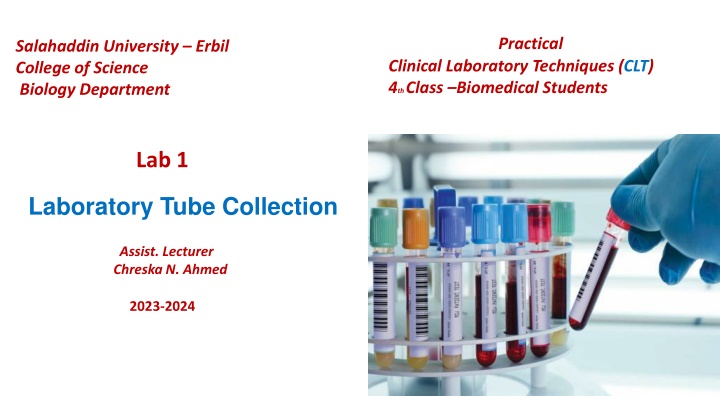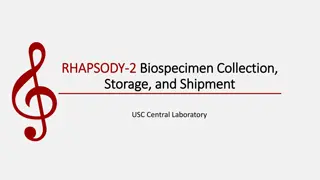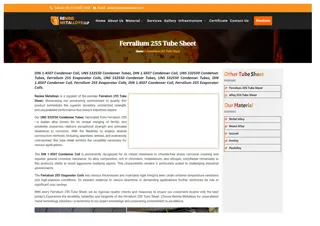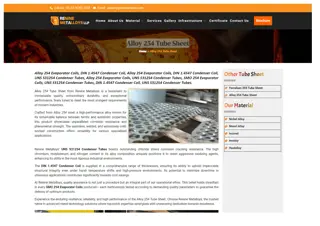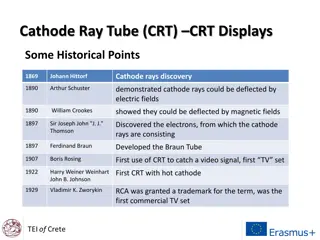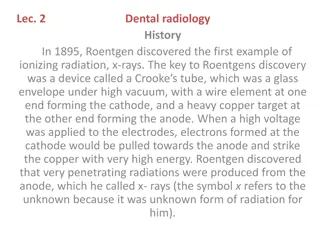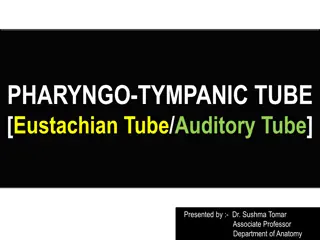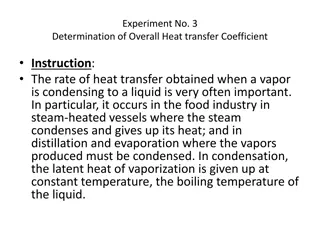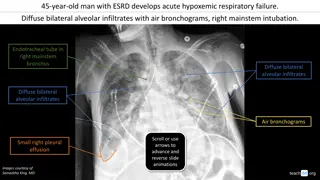Laboratory Tube Collection in Clinical Laboratory Techniques
Laboratory tube collection is a vital process in withdrawing blood samples for testing in clinical laboratories. It follows the order of draw principle and utilizes color-coded tubes for easy identification based on the CLSI recommendations. Understanding the types of blood collection tubes, such as serum, plasma, and whole blood, is crucial for accurate testing procedures and optimal results.
Download Presentation

Please find below an Image/Link to download the presentation.
The content on the website is provided AS IS for your information and personal use only. It may not be sold, licensed, or shared on other websites without obtaining consent from the author.If you encounter any issues during the download, it is possible that the publisher has removed the file from their server.
You are allowed to download the files provided on this website for personal or commercial use, subject to the condition that they are used lawfully. All files are the property of their respective owners.
The content on the website is provided AS IS for your information and personal use only. It may not be sold, licensed, or shared on other websites without obtaining consent from the author.
E N D
Presentation Transcript
Practical Salahaddin University Erbil College of Science Biology Department Clinical Laboratory Techniques (CLT) 4th Class Biomedical Students Lab 1 Laboratory Tube Collection Assist. Lecturer Chreska N. Ahmed 2023-2024
Laboratory Tube Collection Laboratory tube collection is a process applied when withdrawing blood samples from patients before they get tested in the laboratory. It follows the principle, which is most commonly known as the "order of draw." Different tests and biochemical assays require varying types of sample collection tubes. The reason why tubes are color-coded is for practical and easy identification. In-vitro analysis of blood samples can be performed in clinical laboratories. However, these blood samples come in different forms. Testing procedures can require any of the following blood sample types: serum or plasma. In performing multiple collections of venous and/or arterial blood samples in a single patient, a color sequence of withdrawing and its indications based on the Clinical & Laboratory Standards Institute (CLSI) is the recommended procedure.
Blood Specimen Collection Tubes The accuracy of laboratory testing depends on the quality of the specimen submitted. Proper specimen collection, identification, and transport determine the accuracy and utility of the test results. Blood Collection: Serum: Draw a sufficient amount of whole blood into a plain, red top tube or a serum gel tube. Gently invert the tube several times after collection to activate clotting. Allow blood to clot at ambient temperature for 20 to 30 minutes. Centrifuge for 10 minutes to separate the serum from clot and transfer the serum to a screw-capped, plastic vial labeled Serum . This process should be completed within 1 hour of collecting the specimen for optimal results. *Note: There are some tests that require serum, where serum gel tubes should not be used. These are identified in the test catalog. The gel in the tubes can interfere with certain testing methods/tests.
Plasma: Draw a sufficient amount of whole blood into a tube containing the proper anticoagulant. Immediately invert the tube gently several times to mix. Centrifuge for 10 minutes to separate the plasma from the cells and transfer the plasma to a screw- capped, plastic vial labeled with anticoagulant type or Plasma . This process should be completed within 30 minutes of collecting the specimen for optimal results. Examples of anticoagulant collection tubes include: Green Top (sodium or lithium heparin), Lavender Top (EDTA), and Light Blue Top (sodium citrate). Whole Blood: Draw a sufficient amount of whole blood into a tube containing the proper anticoagulant. Immediately invert the tube gently several times to mix. Leave specimen in original tube.
Blood Sample Collection Tubes with Yellow Cap (Gel & Clot Activator Tube) This type of test tube is used in most analyses and laboratory tests such as; Blood chemistry, hormones, and other tests, whereby it is based on the separation of blood serum, through silica particles, and gel, so that the silica particles accelerate blood clotting and coagulation, while the gel separates red blood cells from plasma by floating Between them, then using a centrifuge, the blood serum is separated and will be in the upper yellow layer. Examples of the tests that can use this tube are the following: Biochemistry analyses such as; Fats, kidney and liver function tests, thyroid tests, and vitamins such as vitamin B12. Endocrine examinations such as; Cortisol, and sex hormones. Analyses of tumor markers. Blood toxicology tests. Microbiology and immunology tests.
Blood Sample Collection Tubes with Purple Cap (Gel & EDTA. K3 Tube) The Purple blood sample collection tubes contain an anticoagulant called EDTA, which is a short name for ethylenediaminetetraacetic acid, as this substance binds to calcium in the blood, preventing it from clotting. These tubes are also used in comprehensive blood tests, which require the whole blood sample and all of its cells. Examples of tests that require this type are: Blood complete CBC test. ESR erythrocyte sedimentation rate. HbA1C cumulative blood sugar test. Dealing with this type of test tube requires making sure that the blood is mixed with the anticoagulant, so it must be stirred for 8 minutes to mix well, by turning it frequently.
Blood Sample Collection Tubes with Blue Cap Generally used for haematology tests, contains sodium citrate; As a reflective agent for blood clotting, Sodium citrate binds to calcium ions to prevent coagulation so that it is used in blood clotting tests, calculating bleeding time, in addition to important blood coagulation tests such as D- dimer. that the tube shall be filled to the limit, or the line drawn on it; As more, or less than that will not be good for examination. Blood Sample Collection Tubes with black Cap Additive: 3.8% Sodium Citrate Material: Glass/PET Tube Size: 13*75mm, 8*120mm Applications: blood collection and anticoagulation for Automated Erythrocyte Sedimentation Rate ESR Analyzers sedimentation rate test
Blood Sample Collection Tubes with Pink Cap It works with the same purple tube mechanism, but it is used more in blood transfusion analyses of blood samples, as it also contains the anticoagulant substance EDTA, and is used to examine the patient s blood group, then compare it with other types to reach the appropriate type for the blood transfusion, or the so-called cross match, As for the method of its use, it is similar to the first type in that, as you need constant stirring to mix with the substance, an anti-coagulant. Blood Sample Collection Tubes with gray Cap Cap Color: Grey Additive: Sodium Fluoride/Heparin Suction Volume: 2ml 5ml Material: Glass/PET Tube Size: 13*75mm; 13*100mm; 16*100mm Applications: blood collection for the test like blood sugar, sugar tolerance, erythrocyte electrophoresis, etc.
Blood Sample Collection Tubes with Red Cap It is not common to use it, it contains silica particles inside it as a clot activator to separate blood serum, it can be used in hormone tests, and toxicology tests, but the yellow color has got all the share in that, and it can be found in the glass form of it. Blood Sample Collection Tubes with Dark Green Cap This less frequently used bottle is intended for biochemistry tests that require heparinized plasma, or whole blood for analysis, and can also contain sodium heparin which works as an anticoagulant, common tests performed with a dark green blood sample collection tubes are as follows: ammonia Insulin. Renin, and aldosterone.
